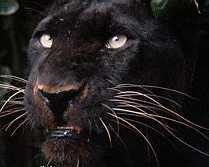
Report from Chris Smith
Sightings spark fears of big cats breeding
In the Wild: From Scotland to Dartmoor, from Bala to Boncath, people are seeing strange animals
By Steve Dube West Wales Correspondent in the Western Mail 17 th August 1999
 There's big business in beasts. The Loch Ness monster has spawned an industry that embraces tourism and literature, while mysterious tales of the Beast of Bodmin have given an extra dimension to visits to the Cornish Moor.
There's big business in beasts. The Loch Ness monster has spawned an industry that embraces tourism and literature, while mysterious tales of the Beast of Bodmin have given an extra dimension to visits to the Cornish Moor.
The trend towards mysterious beasts is growing in Wales, where a series of stories about wild cats and snakes are almost out of control.
New Quay Zoo in Cornwall has just been sponsored by a local company with £1,500 of infrared equipment to help investigate, and if necessary catch, a big cat.
"We have had 290 positive sightings in the past five years," said Pontypool-born Mike Thomas, director of the zoo.
"We reckon there are hundreds about and we have lots of paw prints and photographs to prove it. We get reports mainly from Norfolk, the West Midlands, and South Wales and I believe they have interbred with our native wild cats."
It will be a long time before the Beast of Boncath or Brechfa achieve the same notoriety as the Beast of Bodmin, let alone the Loch Ness monster.
That beast has two visitor attractions devoted exclusively to it and thousands visit the area every year.
"Whether you believe it or not it has raised the profile of the area," said Siobhan Daley of the Scottish Tourist Board.
"We have our own native wild cats up here, but we don't get reports of people being frightened by them. More and more visitors are interested in Scotland's wildlife, although we don't find it's generally a reason for travelling to an area, and certainly not for staying away."
A spokeswoman for the Cornish Tourist Board said it was hard to gauge the effect on visitors to Cornwall.
"I don't think it makes any difference really. It certainly doesn't keep people away. But I suppose it might lend an extra air of mystery to what is already a wild and mysterious place.
"But like in Wales we have many more exciting and intriguing tales to interest the tourist."
In Wales, the latest reports of a big cat in the countryside have failed to be confirmed by paw prints taken at the site. These have turned out to belong to nothing more intriguing than a big dog.
Experts confirmed that a canine creature was responsible for the carnage at Penbryn Park Farm, Whitemill, where six lambs were savaged last weekend.
The incident follows reports of a puma-like creature in the area and is a few miles from the spot where a mare was injured and her foal disappeared without trace last September.
Mr Thomas at New Quay Zoo could have identified it as a dog without leaving Cornwall.
The lambs were horribly savaged and mauled, and Mr Thomas said it was most un-cat like behaviour.
"A cat will kill and eat in a specific way, by breaking the neck of its prey with its strong teeth. Then it will strip off the skin from the neck backwards until the whole of the spinal column and the ribs are exposed.
"If they attack a flock of sheep they will take what they want and drag it away and bury it under sticks or grass and come back to feed on it until they have had enough.
"Dogs are far messier and more indiscriminate and will kill and rip a lamb apart just for fun."
Mr Thomas is convinced that puma and panthers are now breeding in the wild, having been released during the last 23 years when new regulations and licences were introduced to control exotic pets. Before then they were available in stores like Harrods.
"They are genetically compatible with the British wild cat and I believe they have cross-bred to produce a bigger strain."
Wild cats can grow up to three-and-a-half feet long compared with up to 18 inches for a domestic cat. Offspring of an exotic cat would be bigger still.
"They survive all right on mice and rabbits, but we have had a lot of kills reported by farmers in South Wales recently and we're certainly willing to come and investigate."
As well as in Wales, sightings of big cats have been reported in Norfolk, the West Midlands, Bodmin Moor and Dartmoor; wild cats, which can grow to a length of more than 40 inches, are endemic in Scotland
Western Mail: 17 th August 1999
 |
 |
 |
| Return to index | Return to Scottish Big Cats | Return to Scotland |